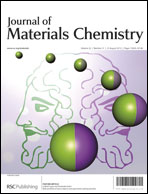Morphology-controlled synthesis of silica nanotubes through pH- and sequence-responsive morphological change of bacterial flagellar biotemplates†
Abstract
Bacterial flagella are naturally occurring self-assembling protein nanofibers protruding from the bacterial surface to assist the swimming of bacteria. They are rigid and exhibit diverse morphologies depending on the ionic strength, the pH values, temperature, and subunit sequences. Here, silica nanotubes (SNTs) with controllable morphologies were synthesized using flagella as biological templates in aqueous solution under mild conditions. The morphologies and surface features of flagella-templated SNTs can be simply tuned by adjusting the pH value or surface chemistry of flagella by peptide display. A variety of different morphologies (coiled, straight, and curly with different wavelengths) and surface features (smooth, rough, granular and pearl-necklace-like) of SNTs were obtained. When pH varies from acidic to alkaline conditions, in general, SNTs varied from bundled coiled, to characteristic sinusoidal waves, helical, and straight morphologies. Under genetic control, flagella displaying negatively charged peptides exhibited thinner layer of silica condensation but a rougher surface. However, flagella with positively charged peptide inserts induced the deposition of a thicker silica shell with a smoother surface. Incorporation of hydroxyl bearing amino acid residues such as Ser into the peptide displayed on flagella highly enhanced the biotemplated deposition of silica. This work suggests that bacterial flagella are promising biotemplates for developing an environmentally benign and cost-efficient approach to morphology-controlled synthesis of nanotubes. Moreover, the dependency of the thickness of the silica shell on the peptides displayed on flagella helps us to further understand the mechanism of biomimetic nucleation of silica on biological templates.


 Please wait while we load your content...
Please wait while we load your content...